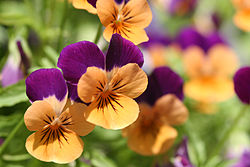Plant physiology
Plant physiology is the part of botany which studies how plants work. That is the physiology of plants.[1] Using a variety of methods, botanists study how plants reproduce, grow, get nutrients, photosynthesise, get water, and so on.
The main topics of plant physiology are photosynthesis, respiration, plant nutrition, plant hormones, tropism, nastic movement, photoperiodism, photomorphogenesis, circadian rhythms, environmental stress physiology, seed germination, dormancy, stomata function and transpiration.
Plant Physiology Media
Latex being collected from a tapped rubber tree.
Space-filling model of the chlorophyll molecule.
Anthocyanin gives these pansies their dark purple pigmentation.
A mutation that stops Arabidopsis thaliana responding to auxin causes abnormal growth (right)
The poinsettia is a short-day plant, requiring two months of long nights prior to blooming.
Phototropism in Arabidopsis thaliana is regulated by blue to UV light.
Powdery mildew on crop leaves
Related pages
References
- ↑ Frank B. Salisbury; Cleon W. Ross (1992). Plant physiology. Brooks/Cole Pub Co. ISBN 0-534-15162-0.








